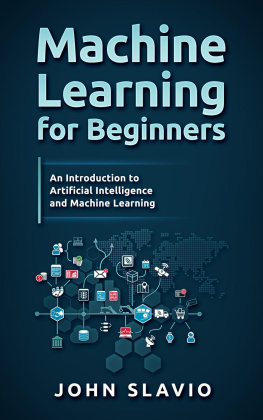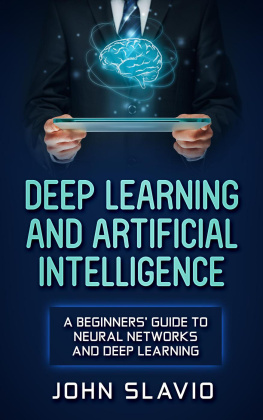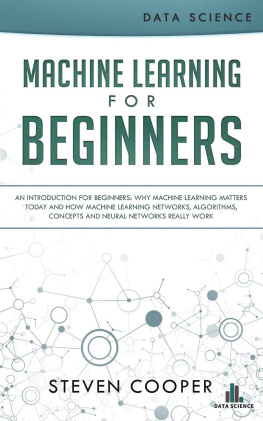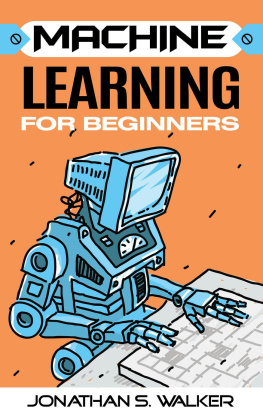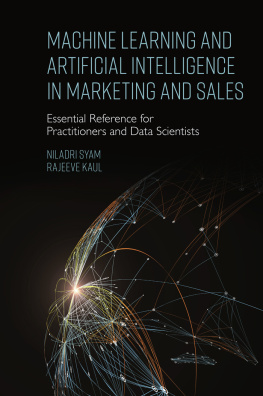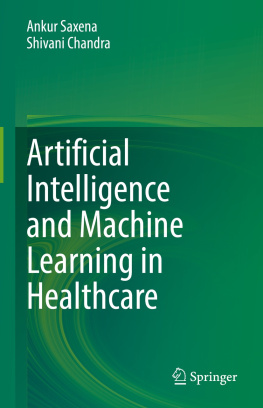John Slavio - Machine Learning for Beginners: A Plain English Introduction to Artificial Intelligence and Machine Learning
Here you can read online John Slavio - Machine Learning for Beginners: A Plain English Introduction to Artificial Intelligence and Machine Learning full text of the book (entire story) in english for free. Download pdf and epub, get meaning, cover and reviews about this ebook. year: 2018, publisher: Abhishek Kumar, genre: Romance novel. Description of the work, (preface) as well as reviews are available. Best literature library LitArk.com created for fans of good reading and offers a wide selection of genres:
Romance novel
Science fiction
Adventure
Detective
Science
History
Home and family
Prose
Art
Politics
Computer
Non-fiction
Religion
Business
Children
Humor
Choose a favorite category and find really read worthwhile books. Enjoy immersion in the world of imagination, feel the emotions of the characters or learn something new for yourself, make an fascinating discovery.
- Book:Machine Learning for Beginners: A Plain English Introduction to Artificial Intelligence and Machine Learning
- Author:
- Publisher:Abhishek Kumar
- Genre:
- Year:2018
- Rating:5 / 5
- Favourites:Add to favourites
- Your mark:
- 100
- 1
- 2
- 3
- 4
- 5
Machine Learning for Beginners: A Plain English Introduction to Artificial Intelligence and Machine Learning: summary, description and annotation
We offer to read an annotation, description, summary or preface (depends on what the author of the book "Machine Learning for Beginners: A Plain English Introduction to Artificial Intelligence and Machine Learning" wrote himself). If you haven't found the necessary information about the book — write in the comments, we will try to find it.
John Slavio: author's other books
Who wrote Machine Learning for Beginners: A Plain English Introduction to Artificial Intelligence and Machine Learning? Find out the surname, the name of the author of the book and a list of all author's works by series.
Machine Learning for Beginners: A Plain English Introduction to Artificial Intelligence and Machine Learning — read online for free the complete book (whole text) full work
Below is the text of the book, divided by pages. System saving the place of the last page read, allows you to conveniently read the book "Machine Learning for Beginners: A Plain English Introduction to Artificial Intelligence and Machine Learning" online for free, without having to search again every time where you left off. Put a bookmark, and you can go to the page where you finished reading at any time.
Font size:
Interval:
Bookmark:
machine learning
Author: John Slavio
 |  |


Copyright 2017 John Slavio
All Rights Reserved
N o part of this eBook can be transmitted or reproduced in any form including print, electronic, photocopying, scanning, mechanical, or recording without prior written permission from the author.
While the author has taken the utmost effort to ensure the accuracy of the written content, all readers are advised to follow information mentioned herein at their own risk. The author cannot be held responsible for any personal or commercial damage caused by information. All readers are encouraged to seek professional advice when needed.
 |  |


J ohn Slavio is a programmer who is passionate about the reach of the internet and the interaction of the internet with daily devices. He has automated several home devices to make them 'smart' and connect them to high speed internet. His passions involve computer security, iOT, hardware programming and blogging.
 |  |


T o understand what machine learning is and how it's important to our everyday lives, you first have to go over what programming is and how machine-learning relates to it. In programming, everything is sequential, meaning that once one command from line 1 is completed then the program goes on to the next line to carry out the next command. However, due to how information is saved within a computer, we have temporary access to previous information that can then be changed and the subsequent information that is based on that information is changed after that.
This is due to something called a Memory Reference, which is assigned to any information inside of the computer. You can think of a memory reference as a location of a house inside of a neighborhood. Therefore, you can tell your driver to go down a neighborhood of addresses and then, once you see the house you're looking for, you can have them perform a U-turn so that you can arrive at the address that you were trying to get to. This is conceptually similar to how an Unordered Array Sort works inside of programming. There have been many methods of making such a path such as the infamous GOTO method from the early days of programming to the more modern methods of running Loops and Recursion.
Machine learning doesn't work without a loop or a method of recursion because machine learning is the machine finding a successful result, storing it, and then rerunning the program so that it further refines what it finds as a successful result. This allows the machine to not only optimize the path towards getting that successful result but also for it to learn how to do something. Therefore, machine learning can be described as a machine going to a specific address several times but each time that it is set to go to that address, it remembers how it got there in the first place and searches for more optimal paths to get there faster.
Lets walk through a scenario so that you can get a better grasp of what I mean by this because this can be a very confusing topic to discuss no matter what level you are at with programming. Imagine that you purchased a brand-new game and you have no idea how to play it. You also bought a new console that has buttons that you have never played with before. The very first time that you boot up the game, you need to learn all the new moves but the game that you bought doesn't included a tutorial so you just have to continually press buttons to figure out what things do. You are, however, handed a single goal that you must accomplish by the time you get to the end of the level. Therefore, you spend a small amount of time or even large amount of time just figuring out how everything moves in the current space that you've been given. Once you understand, on the most basic level, how these buttons work you begin to push yourself towards the goal but the second you die you have to start out at the beginning. As a human being, you remember everything you did beforehand in order to figure out how the buttons worked. Your measure of success is how far you get towards that goal. You then begin to work your way towards the goal and continue to die and make mistakes until you finally manage to accomplish that goal.
This is essentially what machine learning is doing, but with a few key differences. The first difference is that the computer doesn't even know how games work. That, in it of itself, is bizarre and extremely hard to conceptualize since it involves not knowing something that's been around with you since, probably, birth. However, it is given certain functions that it can utilize in order to go further in the game but it doesn't know what those functions will do for it and how to utilize those functions to the best degree. Even worse, the control schema is usually un-made for the program. In other words, not only is the computer usually not handed the controller with buttons but it doesn't even know that buttons exist. It has to first create the controller in order to do anything in the first place. Therefore, it knows that the rules of its program say that it's required to move in a specific direction and that it has to accomplish a goal. It has to create a system for it to move and since it knows that there is a rule about X and Y when it comes to movement on the screen, it develops calculations that will help it move on the screen. Once it remembers how to create those from scratch by placing the information in the save file, it can then begin to move on the screen but it still doesn't know what the best direction is. Therefore, it will move in one direction until it figures out that it needs to move in multiple directions. Once it figures out that it needs to multiply the amount of directions that it moves in, it then begins to test different movement paths in order to optimize what it knows at the current time. Some movements will seem like an optimization, for the human being that is watching the machine learning taking place, but sometimes the computer believes that the action didn't result in the appropriate outcome. Therefore, sometimes when the computer has moved exceedingly far but gets a false negative result, it will revert back to a previous stage in order to further optimize where it is going. This is just how the machine learning begins in a machine learning environment and this is only one case where machine learning has been applied before; simply so that other people can conceptualize what machine learning does. This also represents one particular type of machine learning called unsupervised machine learning, which simply means that the program will continue to do something until it fails and then once it fails it will utilize all the data that it has gathered to optimize and further its goals towards accomplishing the one goal that you handed it. However, there are several different forms of learning for machines because humans handle things differently.
Next pageFont size:
Interval:
Bookmark:
Similar books «Machine Learning for Beginners: A Plain English Introduction to Artificial Intelligence and Machine Learning»
Look at similar books to Machine Learning for Beginners: A Plain English Introduction to Artificial Intelligence and Machine Learning. We have selected literature similar in name and meaning in the hope of providing readers with more options to find new, interesting, not yet read works.
Discussion, reviews of the book Machine Learning for Beginners: A Plain English Introduction to Artificial Intelligence and Machine Learning and just readers' own opinions. Leave your comments, write what you think about the work, its meaning or the main characters. Specify what exactly you liked and what you didn't like, and why you think so.

